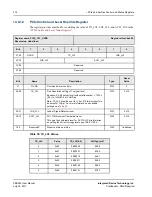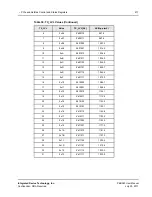
15. Electrical Characteristics > AC Timing Specifications
230
PEB383 User Manual
July 25, 2011
Integrated Device Technology, Inc.
Confidential - NDA Required
15.6.4
Reference Clock
The following table lists the PEB383’s electrical characteristics for the differential SerDes reference
clock input (PCIE_REFCLK_n/p).
Figure 42: Weighing Function for RMS Phase Jitter Calculation
Table 49: Reference Clock (PCIE_REFCLK_n/p) Electrical Characteristics
Symbol
Parameter
Min.
Typ.
Max.
Unit
Notes
V
DIFF
Differential Input Voltage
350
710
850
mV
-
V
CM
Differential Input
Common Mode Range
[(PCIE_REFCLK_p
+PCIE_REFCLK_n)/2]
175
-
2000
mV
-
Fin
Input Clock Frequency
-
100
-
MHz
-
F
PCIE_REFCLK_P/N
Reference Clock
Frequency Tolerance
-300
-
+300
ppm
ppm with respect to
100 MHz, based on the
PCIe Specification.
Fin_DC
Reference Clock Duty
Cycle
40
50
60
%
-
J
CLK-REF
Total Phase Jitter (rms)
-
-
3
ps
rms
See
a
.
a.
Total Permissible Phase Jitter on the Reference Clock is 3 ps rms. This value is specified with assumption that the
measurement is performed with a 20 GSamples/s scope with more than 1 million samples. The zero-crossing times of each
rising edges are recorded and an average Reference Clock is calculated. This average period may be subtracted from each
sequential, instantaneous period to find the difference between each reference clock rising edge and the ideal placement to
produce the Phase Jitter Sequence. The PSD of the phase jitter is calculated and integrated after being weighted with the
transfer function shown in
. The square root of the resulting integral is the rms Total Phase Jitter.
Zin
Input Impedance
-
-
-
-
PCIe_REFCLK_p/n is a
high-impedance input.
Magnitude
0 dB
20 dB/Decade
40 dB/Decade
1.5 MHz
10 MHz
Frequency
















































